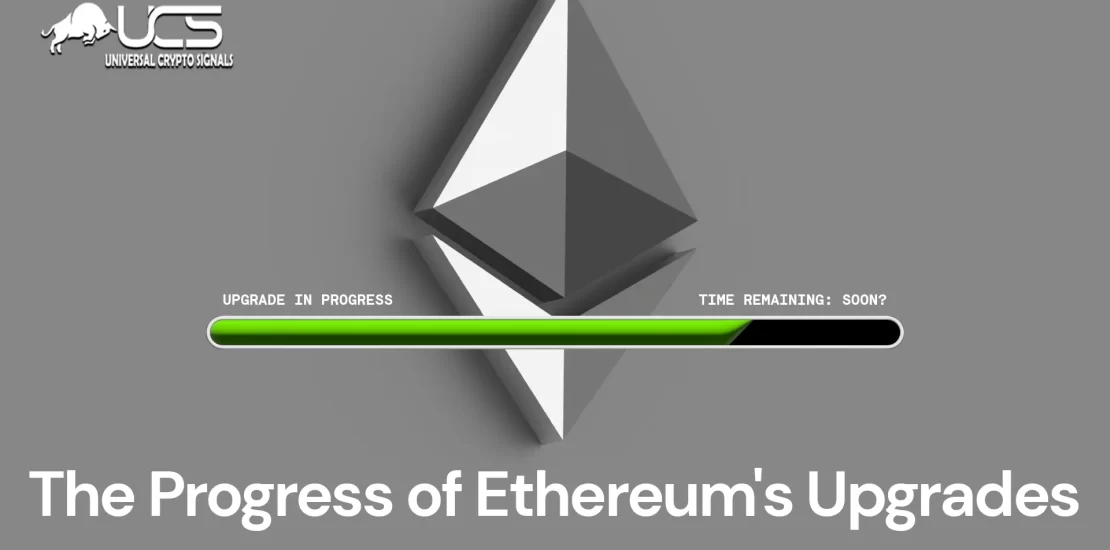- December 28, 2023
- Posted by: Jackson Bennett
- Category: ethereum, News

Introduction
Ethereum Upgrades, the platform for many apps, has grown a lot since it started. It’s known for things like smart contracts, DeFi, NFTs, GameFi, the Metaverse, and Web3. But as more people use it, there are worries about how well it can handle things like lots of users, energy use, and fees.
To fix these issues, the people working on Ethereum are making a bunch of upgrades called Ethereum 2.0. These changes are meant to make Ethereum work better and be more useful for everyday things. This article talks about what’s coming next for Ethereum and how it’s going to keep growing.
Ethereum 2.0: A Recap of the Milestones
Ethereum 2.0 is like a big update to make Ethereum work better. It started with the Beacon Chain in December 2020, changing how Ethereum agrees on things. In 2021, there were upgrades like Berlin and London that made fees better. Then came Altair and Arrow Glacier, which improved the Beacon Chain and delayed a problem.
In 2022, there were more upgrades called Gray Glacier, Bellatrix, and Paris, also known as ‘The Merge.’ These changes made Ethereum switch from using miners to something called validators, making it work in a new and improved way.
After the Shanghai Upgrade
The newest change in Ethereum’s plan was the Shanghai Upgrade in April 2023. This update, with something called EIP-4895, let validators get back the ETH they put into the network. This made more ETH available, which is good for the cryptocurrency market.
In the Shanghai update, the Beacon Chain also got a Capella upgrade. This let validator nodes (the computers that help Ethereum work) with ETH get ready for the Shanghai Upgrade by updating some information. It’s like getting everything ready for a big change in how Ethereum works.
Read Also:- How To Trade Ethereum
Danksharding: The Next Phase in Ethereum 2.0
Danksharding is a big improvement coming to Ethereum 2.0. It’s like a change to how Ethereum handles a lot of information. Instead of one big piece, it will spread the work across different parts. This makes Ethereum work better and costs less to store data. It also lets more people help out by becoming validators, making it more fair and secure.
Proto-Danksharding: EIP-4844
EIP-4844, or Proto-Danksharding, is like the first step in making Danksharding work for Ethereum. It’s trying to fix a problem with how much Ethereum can handle at once. It does this by making the space for transactions bigger, which makes it cheaper for people to use Ethereum and makes everything work better.
Proto-Danksharding also brings in temporary data blobs, which are like small bits of information that can be easily moved around and connected to blocks. These blobs give extra information to the Ethereum system, but they automatically disappear after a certain time (one to three months). This change will make things cheaper for a specific type of transaction on Ethereum, giving users more affordable options.
Full Danksharding
Full Danksharding is like the next big step after Proto-Danksharding for making Ethereum work better. It takes the small bits of information (blobs) that were added in Proto-Danksharding and makes them even bigger, going from 1 to 64. This creates a lot of space for storing transaction details in a more organized way.
With Full Danksharding, Ethereum will be able to support many different types of transactions all at once, like a hundred different tasks. This means Ethereum can handle a huge number of transactions, making it much faster – like millions of transactions every second. It’s a big upgrade to make Ethereum super efficient.
Expected Timeline
Making Danksharding for Ethereum might take a few years, but the first part, Proto-Danksharding, could happen sooner. EIP-4844, which is like the plan for Proto-Danksharding, is well-developed, with agreed-upon details and models already made. After the recent Shanghai update, these changes might be tested on a public trial version to make sure they work well before being used by everyone. Some experts think Ethereum might be able to do sharding by the end of 2023 or early 2024.
Ethereum Major Upgrades
The Beacon Chain
On December 1, 2020, Ethereum took its first step in changing how it works. The Beacon Chain upgrade was like a new boss that helps Ethereum make and check new blocks, and it gives Ethereum coins (ETH) to those who help out (validators). It also introduced a way to lock up ETH to help with this process. Later, the original way Ethereum worked, called PoW, would join with this new way to become one.
Ethereum’s Merge
On September 6, 2022, Ethereum had a big change called the Ethereum Merge. It brought together the original way Ethereum worked (PoW) with the new way (sharded PoS Beacon Chain). All the smart contracts and transaction info moved to the Beacon Chain, finishing the switch to the new way Ethereum operates.
Sharding
In 2023 or 2024, Ethereum plans a big upgrade called sharding to make it work better. The details are still being worked out as the team looks at new technology.
There are two main ideas. First, it’s like using sharded blockchains as a computer’s memory (RAM). This helps store data for the main Ethereum system, making it handle more transactions. Second, it involves doing tasks on the separate parts (shards) themselves. Each part would have its own set of smart contracts and account info that it shares with the whole Ethereum system.
Read also :-Ethereum Price Outlook
Other Ethereum Upgrades Worth Knowing
Ethereum London Hard Fork
On August 5, 2021, Ethereum had a big update called the London Hard Fork to get ready for a change in how it works. It included five improvements (EIPs). The most significant one was adding a new way of handling transactions and making sure there’s less Ethereum created over time (deflationary mechanism). Instead of bidding for transaction space, there’s now a fixed fee for each block. The time bomb that makes things harder for miners was also delayed until December 2021, which matched the plan for another significant upgrade called the Merge.
Ethereum Arrow Glacier Upgrade
On December 9, 2021, Ethereum had a small update called the Arrow Glacier Upgrade. Its main job was to delay a problem called the difficulty time bomb once again. The team wanted to make sure everything keeps working smoothly, and they aimed to push back the “ice age” to June 2022.
Conclusion
Ethereum has made big changes, switching to Proof of Stake and making things better with the Shanghai Upgrade. Now, they’re busy with something called Danksharding to deal with more data and transactions, starting with Proto-Danksharding. This makes Ethereum handle things better, like handling more stuff and costing less. Ethereum is always getting better, and earlier updates like the London Hard Fork are making the path for even more improvements. The goal is to work more smoothly and manage lots of transactions.
Add a comment
You must be logged in to post a comment.



